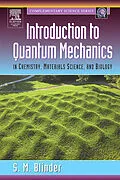Blinder also discusses recent conceptual developments in quantum theory, including Schrödinger's Cat, the Einstein-Podolsky-Rosen experiment, Bell's theorem and quantum computing.
* Clearly presents the basics of quantum mechanics and modern developments in the field
* Explains applications to molecular spectroscopy, lasers, NMR, and MRI
* Introduces new concepts such as Schrödinger's Cat, Bell's Theorem, and quantum computing
* Includes full-color illustrations, proven pedagogical features, and links to online materials
Introduction to Quantum Mechanics provides a lucid, up-to-date introduction to the principles of quantum mechanics at the level of undergraduates and first-year graduate students in chemistry, materials science, biology and related fields. It shows how the fundamental concepts of quantum theory arose from classic experiments in physics and chemistry, and presents the quantum-mechanical foundations of modern techniques including molecular spectroscopy, lasers and NMR. Blinder also discusses recent conceptual developments in quantum theory, including Schrödinger's Cat, the Einstein-Podolsky-Rosen experiment, Bell's theorem and quantum computing. - Clearly presents the basics of quantum mechanics and modern developments in the field - Explains applications to molecular spectroscopy, lasers, NMR, and MRI - Introduces new concepts such as Schrödinger's Cat, Bell's Theorem, and quantum computing - Includes full-color illustrations, proven pedagogical features, and links to online materials
Autorentext
Professor Blinder is Professor Emeritus of Chemistry and Physics at the University of Michigan, Ann Arbor and a senior scientist with Wolfram Research Inc., Champaign, IL.. After receiving his A.B. in Physics and Chemistry from Cornell University, he went on to receive an A. M in Physics, and a Ph. D. in Chemical Physics from Harvard University under Professors W. E. Moffitt and J. H. Van Vleck.
He has held positions at Johns Hopkins University, Carnegie-Mellon University, Harvard University, University College London, Centre de Méchanique Ondulatoire Appliquée in Paris, the Mathematical Institute in Oxford, and the University of Michigan.
Prof Blinder has won multiple awards for his work, published 4 books, and over 100 journal articles. His research interests include Theoretical Chemistry, Mathematical Physics, applications of quantum mechanics to atomic and molecular structure, theory and applications of Coulomb Propagators, structure and self-energy of the electron, supersymmetric quantum field theory, connections between general relativity and quantum mechanics.
Klappentext
Introduction to Quantum Mechanics provides a lucid, up-to-date introduction to the principles of quantum mechanics at the level of undergraduates and first-year graduate students in chemistry, materials science, biology and related fields. It shows how the fundamental concepts of quantum theory arose from classic experiments in physics and chemistry, and presents the quantum-mechanical foundations of modern techniques including molecular spectroscopy, lasers and NMR.
Blinder also discusses recent conceptual developments in quantum theory, including Schrödinger's Cat, the Einstein-Podolsky-Rosen experiment, Bell's theorem and quantum computing.
- Clearly presents the basics of quantum mechanics and modern developments in the field
- Explains applications to molecular spectroscopy, lasers, NMR, and MRI
- Introduces new concepts such as Schrödinger's Cat, Bell's Theorem, and quantum computing
- Includes full-color illustrations, proven pedagogical features, and links to online materials
Inhalt
Preface
1. Atoms and Photons
2. Waves and Particles
3. Simple Systems
4. Principles of Quantum Mechanics
5. Harmonic Oscillator
6. Angular Momentum
7. Hydrogen Atom
8. Helium Atom
9. Atomic Structure
10. The Chemical Bond
11. Diatomic Molecule Orbitals
12. Polyatomic Molecules
13. Molecular Symmetry
14. Molecular Spectroscopy
15. Nuclear Magnetic Resonance
16. Wonders of the Quantum World
Suggested References
Answers to Exercises
